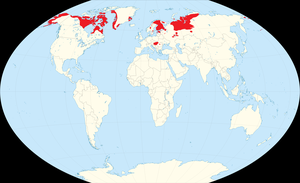| This article may lend undue weight to certain ideas, incidents, or controversies. Please help improve it by rewriting it in a balanced fashion that contextualizes different points of view. (September 2023) (Learn how and when to remove this message) |
| Eskimo–Uralic | |
|---|---|
| (very highly controversial) | |
| Geographic distribution | northern Eurasia and far northern North America |
| Linguistic classification | Proposed language family |
| Subdivisions | |
| Language codes | |
| Glottolog | None |
 Eskimo–Uralic languages Eskimo–Uralic languages | |
The Eskimo–Uralic hypothesis posits that the Uralic and Eskimo–Aleut language families belong to a common macrofamily. It is not generally accepted by linguists because the similarities can also be merely areal features, common to unrelated language families. In 1818, the Danish linguist Rasmus Rask grouped together the languages of Greenlandic and Finnish. The Eskimo–Uralic hypothesis was put forward by Knut Bergsland in 1959. Ante Aikio stated that it's possible that there exists some connection between the two families, but exact conclusions can't be drawn and the similarities could exist by loaning.
A similar theory was suggested in 1998 by Michael Fortescue, in his book Language Relations across Bering Strait where he proposed the Uralo-Siberian theory, which, unlike the Eskimo-Uralic hypothesis includes the Yukaghir languages, argues that Uralo-Siberian influenced Chukotko-Kamchatkan and some have included Nivkh as a part of the family.
At present the arguments used to defend the Eskimo-Uralic theory are insufficient to even suspect a relationship between the languages, let alone to make an affirmative case for their relationship.
History
Comparisons between Uralic and Eskimo–Aleut languages were made early. In 1746, the Danish theologian Marcus Wøldike [da] compared Greenlandic to Hungarian. In 1818, Rasmus Rask considered Greenlandic to be related to the Uralic languages, Finnish in particular, and presented a list of lexical correspondences (Rask also considered Uralic and Altaic to be related to each other). In 1871, H. Rink had also theorized of a similar theory. In 1959, Knut Bergsland published the paper The Eskimo–Uralic Hypothesis, in which he, like other authors before him, presented a number of grammatical similarities and a small number of lexical correspondences.
In 1998, Michael Fortescue presented more detailed arguments in his book, Language Relations across Bering Strait. His title evokes Morris Swadesh's 1962 article, "Linguistic relations across the Bering Strait". Besides new proposed linguistic evidence, Fortescue (2016) presents several genetic studies that he argued to support a common origin of the included groups, with a suggested homeland in Northeast Asia.
Proposed Evidence
A few potential lexical cognates between Proto-Uralic and Eskimo–Aleut are pointed out in Aikio (2019: 53–54). These are:
| Proto-Uralic | Proto-Eskimo |
|---|---|
| *ila- ‘place under or below’ | *at(ǝ)- ‘down’; *alaq ‘sole’ |
| *elä- ‘live’ | *ǝt(ǝ)- ‘be’ |
| *tuli- ‘come’ | *tut- ‘arrive, land’; *tulaɣ- |
| *kuda ‘morning, dawn’ | *qilaɣ- ‘sky’ |
| *kuda- ‘weave’ | *qilaɣ- ‘knit, weave’ |
A possible regular sound correspondence with Uralic *-l- and Proto-Eskimo-Aleut *-t can be argued to exist.
According to Ante Aikio The words "morning" and "weave" appear to be completely unrelated, which means there is an instance of coincidental homonymy, which very rarely happens by accident. Aikio thus stated that he believes it to be likely that there exists some connection between the two families, however exact conclusions cannot be drawn and it would not yet prove a direct relationship, as such can happen by loaning.
See also
- Paleosiberian languages
- Proto-Chukotko-Kamchatkan language
- Proto-Uralic language
- Classification of indigenous languages of the Americas
- Linguistic areas of the Americas
- Macrofamily
References
- Bergsland, Knut (1959). The Eskimo-Uralic Hypothesis (in German). na.
- ^ Rask, Rasmus; Thalbitzer, William (January 1921). "The Aleutian Language Compared with Greenlandic". International Journal of American Linguistics. 2 (1/2): 40–57. doi:10.1086/463733. ISSN 0020-7071. S2CID 143810291.
This problem, in reality, had already been taken up earlier, first by the Danish eskimologist H. Rink, later by the French linguist Lucien Adam. The former, in 1871, had referred to the agreement in the dual and plural endings (-k and -t) between the Eskimo language and the Samoyede-Finnish languages The latter had rejected the possibility of classifying the Eskimo either with any American Indian language or with the Uralo-Altaic languages
- Caveney, Geoffrey. "Uralic-Eskimo initial, first vowel, and medial consonant correspondences with 100 lexical examples".
{{cite journal}}: Cite journal requires|journal=(help) - ^ Aikio, Ante (2019). "Proto-Uralic". In Bakró-Nagy, Marianne; Laakso, Johanna; Skribnik, Elena (eds.). Oxford Guide to the Uralic Languages. Oxford, UK: Oxford University Press.
- Fortescue, Michael (1998). Language Relations across Bering Strait: Reappraising the Archaeological and Linguistic Evidence. London and New York: Cassell. ISBN 0-304-70330-3.
- Abondolo, Daniel; Valijärvi, Riitta-Liisa (2023-03-31). The Uralic Languages. Taylor & Francis. ISBN 978-1-317-23097-7.
- Bergsland, Knut (1959). "The Eskimo–Uralic hypothesis". Journal de la Société Finno-Ougrienne. 61: 1–29.
- Swadesh, Morris (1962). "Linguistic relations across the Bering Strait". American Anthropologist. 64 (6): 1262–1291. doi:10.1525/aa.1962.64.6.02a00090.
- "Correlating Palaeo-Siberian languages and populations: recent advances in the Uralo-Siberian hypothesis". ResearchGate. Retrieved 2019-03-22.
- Bergsland, Knut (1979). "The comparison of Eskimo-Aleut and Uralic". Fenno-Ugrica Suecana. 2: 7–18.
- Georg, Stefan; Seefloth, Uwe (2020). "Uralo-Eskimo?". Academia.edu. San Francisco, California: Academia, Inc.
- Seefloth, Uwe (2000). "Die Entstehung polypersonaler Paradigmen im Uralo-Sibirischen". Zentralasiatische Studien. 30: 163–191.
- Künnap, A. 1999. Indo-European-Uralic-Siberian Linguistic and Cultural Contacts. Tartu, Estonia: University of Tartu, Division of Uralic Languages.
| Language families of Eurasia | |||||||
|---|---|---|---|---|---|---|---|
| Europe | |||||||
| West Asia | |||||||
| Caucasus | |||||||
| South Asia | |||||||
| East Asia | |||||||
| Indian Ocean rim | |||||||
| North Asia |
| ||||||
| Proposed groupings |
| ||||||
| Substrata | |||||||
| |||||||